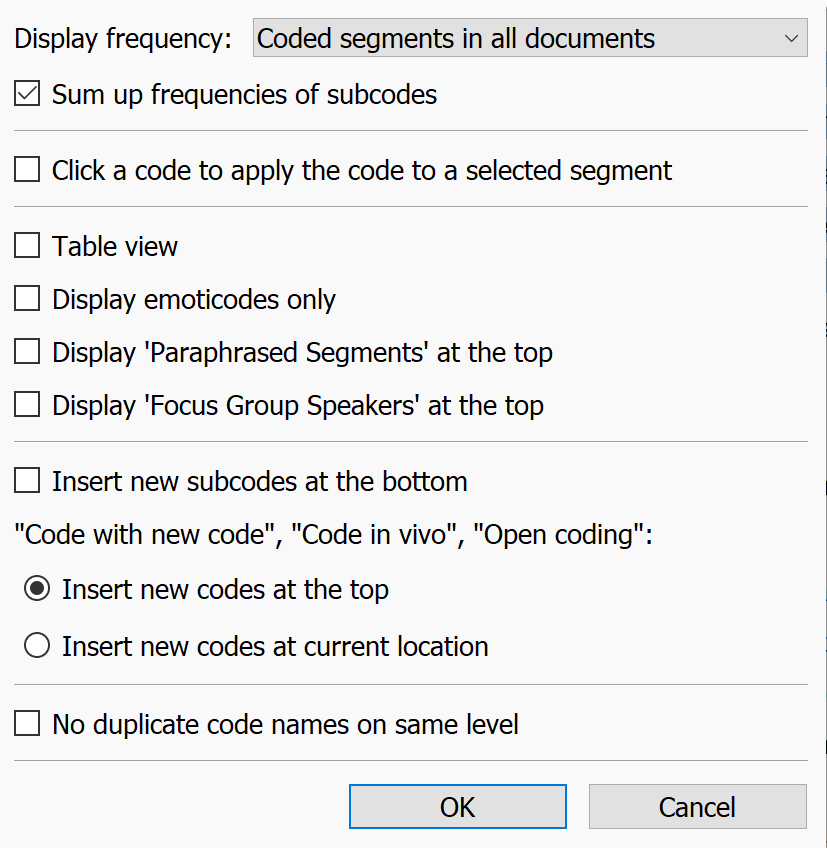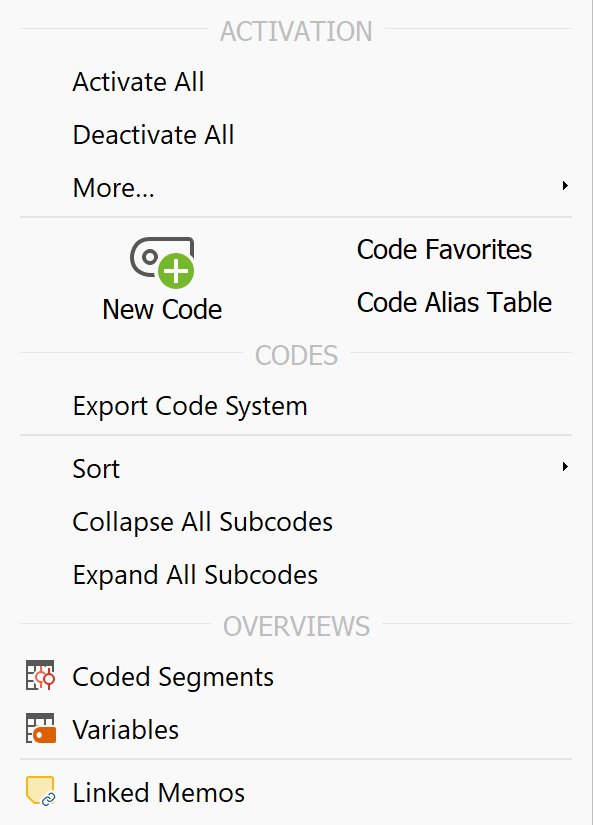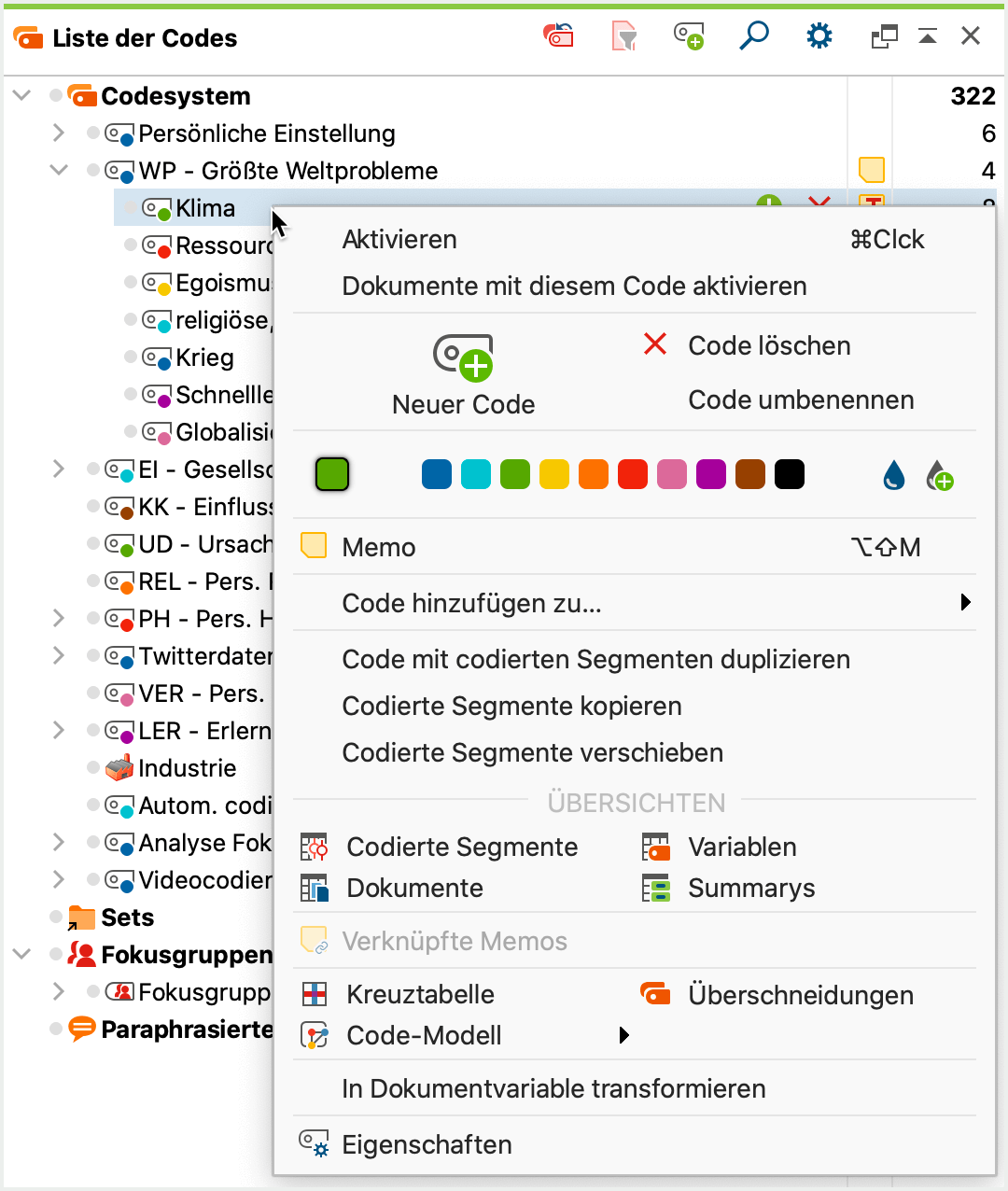Toolbar
The toolbar at the top of the “Code System” window offers quick access to the most commonly-used functions in this window. These functions are:
![]() Reset activations – resets current code activations.
Reset activations – resets current code activations.
Display codes from activated documents only - reduces the code system to codes assigned in at least one of the activated documents.
![]() New code – adds new code into the code system.
New code – adds new code into the code system.
![]() Display search toolbar – allows you to search for a specific code.
Display search toolbar – allows you to search for a specific code.
Settings - opens a dialog box with local settings options (see below)
![]() Undock window
Undock window
![]() Maximize window
Maximize window
![]() Hide window
Hide window
Local Settings
Click on the gear symbol in the "Code System" and the following options dialog will appear with local settings options:

Display frequency of - here you define what the numbers behind the codes should indicate. The setting does not refer to the entries "Paraphrased segments" and "Focus group speaker" in the code system. Is reset to the setting Coded segments of all documents when changing projects.
Sum up frequencies of subcodes - if you collapse a code, the frequencies of the code and all its subcodes will be added if this option is selected.
Click a code to apply a code to a selected segment - if this option is enabled, you can click on a code to apply it to a selected segment instead of having to use drag-and-drop.
Table view - Switches from tree view to tabular view of all entries in the code system. Will be turned off when changing projects.
Display only emoticodes - if this option is enabled, only emoticodes are displayed in the code system and all other entries are hidden. Will be switched off when changing projects.
Display 'Paraphrased Segments' at the top - by default the entry 'Paraphrased Segments' is displayed below the codes. Enable this option to fix the entry at the top of the code system.
Display 'Focus Group Speaker' at the top - by default, the 'Focus Group Speaker' entry is displayed below the codes. Enable this option to fix the entry at the top of the code system.
Insert new subcodes below - by default, new subcodes are inserted directly below the clicked upper code. Activate the option to add new subcodes below the existing subcodes.
"Coding with new code", "Coding in vivo", "Open coding".
Insert new codes at the top - new codes added by the listed coding functions are inserted at the top of the code system.
Insert new codes at current position - Newly added codes are inserted at the current position, i.e. the blue mark, as subcodes.
No duplicate code names on same level - this option prevents codes with the same name from being generated at the same hierarchy level.
The top level in the “Code System”
When you create a new project, the “Code System” is empty except for the “Code System” icon and label. This represents the root directory or folder, the upper level of the “Code System” hierarchy. If you right-click on the symbol or the label next to it, you will see a context menu. Since most selectable functions only apply to a non-empty Code System, some codes have already been inserted into the following illustration.

This menu offers access to the following functions:
Activate All– activates all codes in the entire “Code System”.
Deactivate All– deactivates all codes in the entire “Code System” (except focus group participant codes).
More … > Activate Codes by Variables – allows activation based on code variable values.
More … > Activate Codes by Color – allows activation based on code colors.
More … > Invert Activation – activates all currently deactivated codes and deactivates all currently activated codes in the entire “Code System.”
More … > Load Activation – code activation status will be imported from a file previously created in MAXQDA.
More … > Save Activation – the current activation status of the code system is stored in a file that can be called up at a later time in order to establish this specific activation status.
New Code – creates a new top level code in the code system.
Code Favorites – opens window with your code favorites.
Code Alias Table – Displays a table with all codes that can be assigned an alias with up to 255 characters for each code.
Sort – sorts all subcodes of the current code by alphabetical order or by code frequency.
Collapse All Subcodes – for a better overview all subcodes are reduced so that only the codes at the top level are visible.
Expand All Subcodes – all subcodes are expanded to give a quick view of all codes in the Code System.
Move Activated Codes Here – moves all activated codes to the top level of the “Code System” window. Subcodes of activated codes will keep their position as subcodes as long as they are not activated. This function is only visible if at least one code is actually activated.
Coded Segments – lists all coded segments in the entire project in table form in the Overview of Coded Segments.
Variables – the complete data matrix for code variables is displayed.
Linked Memos – lists all memos that are linked to any code in the “Code System.”
The lower level: individual codes and subcodes
There is also a context menu for the single code/subcode level, which offers functions that affect the code you right-clicked on.

The following functions are shown in the context menu:
Activate Incl. Subcodes / Deactivate Incl. subcodes – the code including all its subcodes are activated or if it is activated, it is deactivated together with the subcodes.
Activate/Deactivate – only the code itself, without its subcodes, is activated.
New Code – creates a new subcode for the selected code.
Delete Code (and Subcodes) – the selected code is deleted. In the alternative view of the “Code System” as Table, several codes can be deleted simultaneously. When a code is deleted, every association to coded segments will be deleted. Subcodes will also be deleted. The removal of codes from a code system can be visualized as the cutting of branches from a tree: when a branch (code) is cut, all attached subcodes and subcodes of subcodes are also cut off.
Rename Code – allows you to create a new name for the code.
(Color Selection) – allows to set a color for the code.
Memo – creates a memo for the clicked code. If a memo already exists, it is opened.
Add Code to … > Code Favorites – the selected code is included in the "Code Favorites" window, which enables a fast coding process for a few selected codes.
Add Code to … > Code set – the selected code is included in a new or existing code set..
Subcodes > Sort – sorts all subcodes of the current code by alphabetical order or by code frequency.
Subcodes > Copy/Paste – copies all subcodes so that they can be pasted into another code.
Move Activated Codes Here – inserts all activated codes as subcodes of the chosen code. Subcodes of activated codes will keep their position as subcodes as long as they are not activated. This function is only visible if at least one code is actually activated.
Duplicate Code with Coded Segments - Creates a copy of the code below the clicked code, including the associated encoded segments.
Copy Coded Segments – copies all coded segments for the selected code, so that they can be copied into a different code. After choosing this option, right-click on the code that you would like to paste these coded segments into and select Paste Coded Segments (from Code 'xyz')
Move Coded Segments – cuts the coded segments from the current code, so you can insert them in a different code. After selecting this option, right-click on the code where you want to move the coded segments to and select Paste Coded Segments (from Code 'xyz').
Coded Segments – opens the Overview of Coded Segments with all coded segments coded with the current code, offering an overview of the text and image segments assigned with the code.
Documents – opens the Overview of Documents with all of the selected documents in which the code was used.
Variables – opens the Data Editor with all code variables of the code and its subcodes.
Summaries – lists all summaries in the entire project in table form in the Overview of Summaries.
Linked Memos – lists all memos that are linked to any code in the “Code System.”
Intersections – All codes that overlap with this code are displayed in a pop-up list, with the most common overlapping codes topping the list. Clicking on an entry in the list displays the corresponding segments that contain overlaps in the "Retrieved Segments" window.
Crosstab – opens the mixed methods "Crosstabs" function, which can be used to compare the code frequencies for groups of documents.
Code Model – opens MAXMaps and creates a map with the chosen Code Model.
Transform into a Document Variable – creates a numerical document variable with the name of the current code in the variable list. The number of times the code appears in each document is entered as the variable value for each document.
Transform into a Categorical Document Variable – creates a new string variable whose value for each document is the subcode that appears most often in that document (only works for codes that have subcodes).
Subcode Statistics – opens a "statistics for subcodes" dialog window for creating a frequency table or a chart of the subcode frequencies of the selected code.
Properties – opens the properties menu, where a color, alias name, and keyboard shortcut can be assigned or changed for a code.
